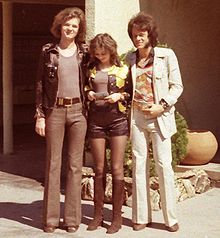Larry Cuban on School Reform and Classroom Practice: Schools and the Economy–Not Yet a Faddish Idea
Fashions in ideas, like clothes, change with the times.

But when they are in fashion, they become the wisdom of the moment. Supply-side economics, embraced by the Republicans during the Reagan presidency, cut taxes and ran up unparalleled deficits. It was group-think wisdom. Sure there were critics but GOP champions called them nail-biting nay-sayers who had no entree to top policy makers or a tuxedo for White House dinners. Within a few years, supply-side economics–or what Reagan’s success George H.W. Bush called “voodoo economics“–rested in a dumpster. Donald Trump gave much visibility to conspiracy theories (e.g., QAnon) and the “deep state”. Prominent in the President’s daily twitter stream, they are the meat-and-potatoes of social and mainstream media now. After Trump vacates the White House, the next Administration will empty these conspiratorial ideas into the ideological trash-bin.
Ditto for fashionable educational ideas. When I was a graduate student four decades ago, I took notes about the dominant ideas that my professors said drove federal and state policy making in the early 1970s: School do not make a difference in children’s lives; socioeconomic status does. Improving schools may be worthwhile work but it is as ineffectual in altering larger society as building sand castles in an incoming tide. Such mainstream thinking elevated a parent’s zipcode and college degree to predestination for the child. These ideas also shrunk efforts to spend money on better teaching for students. It was the academic wisdom of the moment.
Four decades later that “wisdom” has flip-flopped. What is now fashionable is that all children can learn; the school–especially preschool–makes a big difference in getting jobs and settling into a career. And school improvement is crucial to ending economic downturns and spurring growth.
So what else is new? Ideas, like hula-hoops, do come and go out of style.

Kids playing outside with hula hoops.
Ideas, however, have consequences. Supply-side economics was tied to the greedy feeding frenzy of Savings & Loans bankers in the late 1980s that betrayed their investors’ trust. The housing bubble of the 1990s—the idea that houses would appreciate in value forever–burst in 2007 and trillions of dollars sunk into undecipherable mortgage derivatives led to premier financial firms to go belly-up losing investors’ funds in the blink of an eye.
Ideas about schools matter also. Since the A Nation at Risk report (1983), the belief that the nation’s slipping economic competitiveness is largely the result of future workers being educated poorly has been reduced to a bumper sticker slogan: Strong schools = strong economy. Sure. Try selling that bumper sticker to unemployed college-educated professionals who lost their jobs in the Great Recession of 2008 and remain unemployed.
Of course, the quality of schooling is important to graduates’ career advancement and lifetime earnings. Public schooling, for all of its flaws, still remains the last, best hope for the recent immigrant, the poor, and the middle class of this nation. To the degree that graduates find jobs that match their skills and motivation, they do contribute to the economy. But other facts overwhelm what small contributions schools make to the economy. School districts do not generate manufacturing, managerial, and white collar jobs in the economy (except for teachers and administrators, of course); school districts do not make corporate decisions to install new technologies in factories that reduce numbers of workers; school districts do not decide to build plants in China, India, Mexico or Taiwan.
So saying that improving the quality of schooling will pump up a sagging economy, the prevailing wisdom of the moment, is misleading, even mischievous in redirecting attention away from corporate and governmental decisions that affect the economy directly.
What exists is group-think acceptance of “mainstream “wisdom” as it goes in and out of style. Consider how much arm-waving occurred a few decades ago about transforming schools into leaner, smarter organizations–as corporate firms had supposedly done–where decisions are made by those who do the work. Called “restructuring,” and once the rage among educators and business leaders pressing for school change, the hot rhetoric has cooled since the mid-1990s.
Common Core curriculum standards, charters, and new technologies in classrooms are fashionable now. Why? Because of the underlying popular idea—“wisdom of the moment”–that growing a strong economy is an educational problem that must be solved.
In the past decade, Segways, Cabbage Patch dolls, Napster, and Pokemon were popular also. Not now. So those popular educational ideas among pundits, policy elites, and bloggers will cool off as others have in the past. What is far more important, however, is the unexamined assumption within the idea that drives school improvement strategies.
The assumption that somehow improving urban public schools will revive an ailing economy remains largely unexamined and, is, ultimately flawed by its illogic. Yet it continues to fuel one fad after another to improve schools. “Voodoo economics” lasted five years before President Reagan raised taxes and supply-side ideas joined pet rocks in the dustbin of the unfashionable. Presidents Bush I, Clinton, Bush II, Obama, and Trump have pursued the flawed assumption. How long will it take before we assume no longer that public schools are boot camps for the economy but rather places for growing a democratic society?
This blog post has been shared by permission from the author.
Readers wishing to comment on the content are encouraged to do so via the link to the original post.
Find the original post here:
The views expressed by the blogger are not necessarily those of NEPC.
